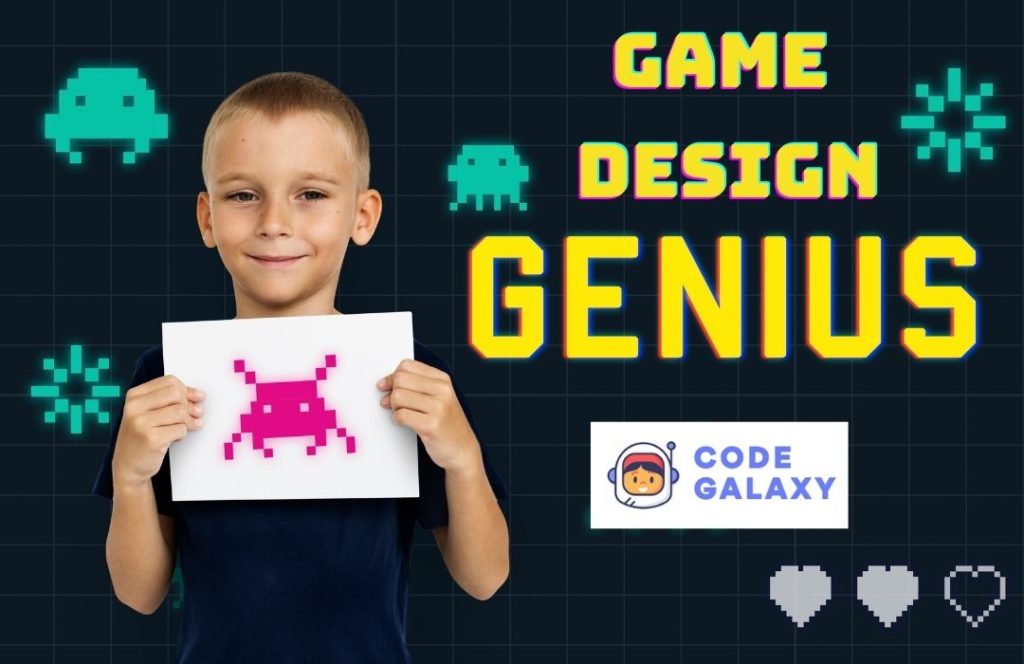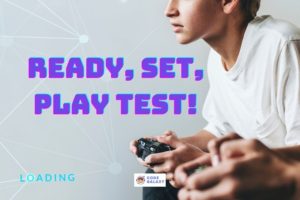Book a FREE Trial
See why Code Galaxy is the #1 online coding
school of choice for students & parents.

If you’ve been keeping up with our blog, it’s no secret that technology continues to grow and merge harmonizing both facets of consumption and creation. This is especially so when learning how to program from how to code a game or design an in-depth application. From a parent’s perspective, finding a balance point where your child is free to explore new frontiers while also creating their own is critical in cultivating a healthy relationship with technology. However, from a youngster’s point of view, the virtual sealing cracks when discovering the limitless possibilities behind game design and creation.
From exercising creative muscles to expanding the capacity for patience, learning how to code a game is a feat filled with fulfillment and personal development on all levels.
Learning how to code a game can be beneficial for many reasons. It can help improve problem-solving skills, communication skills, and creative thinking. In addition, coding a game can be a fun and rewarding experience. Most importantly, for kids, learning how to code a game for beginners stretches the imagination into creating new worlds—ultimately shaping the one we have all come to know for the better.
Before we get into the steps necessary for creating a game, it must be noted that coding a game is both a challenging and rewarding experience. The process is riddled with opportunities to rewire the mind and reach deep levels of patience for problem-solving and overcoming creative hurdles.
If the journey is the destination, by the end of this process your kid will have done more than code a game. They will also have learned how to program their inner landscape to accomplish anything they set their mind to.
So if you’re looking for a way to improve your skills or just want to have some fun, coding a game may be the perfect option for you.
There are many different ways to code a game. Some languages are better suited for certain types of games than others. For example, C++ is often used for first-person shooters and action games, while Java is better suited for strategy games.
No matter what language you choose to code your game in, there are a few basic steps that you will need to follow.
First, you will need to come up with an idea for a game. Once you have an idea, you will need to create a design document that outlines the game’s mechanics and rules. This can be written down on paper or carefully planned in software. All that matters, at this point, is that you get your ideas out of your head and onto a tangible form! The more detailed you can be, the better as this will save you time in the long run.

Some questions to get started might include (but are not limited to):
If you’re not sure where to start with your spring of ideas, consider thinking about the games you like to play with your friends. What do you love about your favorite games and what can you make better? Allow yourself the creative space to dream and envision what you wish to see while also deepening your consumption exchange into deep listening. After all, any pursuit in game design will come with its fair share of receptivity and production. Make sure the work you are putting in is feeding the machine you want to create for maximum fulfillment. The nuggets of information you’ll learn along the way will only serve to make you a better programmer in the long run. Once the designs and ideas are complete, you can begin coding the game by selecting a game engine.
A game engine is a software development environment designed for people to build video games. It provides a framework for game developers to work within, allowing them to create games more quickly and easily. A game engine typically includes a graphics engine, a physics engine, and a scripting language.
Game engines are used by video game developers to create games for multiple platforms including PCs, consoles, and mobile devices. Many popular games are based on engines that are available commercially. Some examples of commercial game engines are Unreal Engine 4, Unity, and GameMaker Studio.
There are many factors to consider when choosing a game engine, such as the target platform, the programming language, the features and tools, and the price. It is important to choose an engine that is compatible with the platform you want to develop for and that has the features and tools you need. Some engines are free to use while others cost money. As a beginner, you’ll benefit from working with a game engine. The more you learn and experience, the better equipped you’ll be to design and program your own game engine.
Once you have chosen a game engine, you will need to learn how to use it. This usually involves reading documentation and following tutorials. Many game engines also have community forums where you can ask questions and get help from other developers. While it may seem like an extra step, learning how to navigate your way through a game engine is often more beneficial than attempting to code a game out of thin air—especially as a beginner!
When developing a game, you will typically start by creating art assets such as 3D models and 2D sprites. These assets are then imported into the game engine where they can be used in the game. The game engine will also handle the physics and collisions between objects in the game.
These are some of the most popular programming languages to consider as you grow.
Scratch is a programming language that makes it easy to create your own interactive stories, animations, games, music, and more. To code a game with Scratch you’ll first want to choose a game template. When you open Scratch, you’ll see several options for different types of projects. For this tutorial, we’ll choose “Game.”
From here, you can familiarize yourself with the blocks and even take a course to learn how to code a game in scratch. This is a great place to start when navigating the ins and outs coding languages—especially for elementary students. Take a look at the various blocks available in Scratch. These are the building blocks for your program. You can find them organized by category in the Blocks Palette on the left side of the screen.
Now you can go ahead and start coding! Begin by dragging out some blocks and connecting them together. For example, you could use the “when green flag clicked” block to start your game when the player clicks on the green flag.
Next, add sprites. Sprites are the characters in your game. You can find them in the Sprite Library on the right side of the screen. To add a sprite to your project, simply click and drag it onto the Stage.
With these steps completed, give your sprite some instructions. Once you’ve added a sprite, you can use blocks to give it instructions. For example, you could use the “move 10 steps” block to make your sprite move across the screen.
Feel free to add more sprites and more code! Continue adding sprites and coding their actions until your game is complete. Then press the “Share” button to share your game with the world!
Scratch is a great programming language for beginners and can be a sufficient starting point for developing into more sophisticated languages in design.
Javascript is a versatile scripting language that can be used to create games of all genres. When coding a game with Javascript, there are a few key things to keep in mind. First, it is important to have a good understanding of the language itself. Secondly, it is important to be familiar with the various libraries and frameworks that are available to help with game development. Finally, it is also important to have a solid plan for your game before starting to code.
With these things in mind, let’s take a look at how to code a game with Javascript.
The first step is to choose the genre of game you want to create. There are many different types of games that can be created with Javascript, so it is important to pick one that you are interested in and have a good understanding of. Once you have chosen a genre, you can begin familiarizing yourself with the various libraries and frameworks that are available.
See why Code Galaxy is the #1 online coding
school of choice for students & parents.
One popular library for game development with Javascript is Phaser.io. Phaser is an open-source framework that helps with the creation of 2D games. It includes features such as sprite management, animation, physics, and input handling. There are also many other libraries and frameworks available, so be sure to explore all of your options before deciding which one to use.
Once you have chosen a library or framework, it is time to start coding your game. When coding a game with Javascript, it is important to start small and gradually add more features as you become more comfortable with the language. A good way to start is by creating a simple “hello world” program. This will allow you to get a feel for the syntax and how the various libraries and frameworks work.
As you continue developing your game, it is important to keep a few things in mind. First, make sure that your code is well organized and easy to read. Secondly, always test your game on multiple browsers and devices to ensure compatibility. Finally, don’t be afraid to ask for help when needed—there are many resources available online that can help you if you get stuck. With a team of leading STEM professionals in our corner, Code Galaxy offers a plethora of resources to help build your coding literacy as you expand into game design.
With these tips in mind, you should be well on your way to coding a great game with Javascript. Just remember to take your time, be organized, and always test your game before releasing it to the public. If you do all of these things, you’ll be sure to create a hit game that everyone will enjoy!
Python is a multipurpose language and can be used for a variety of things—gaming is one of those many things.
There are a lot of ways to code a game with Python. The most popular and easiest way is probably to use Pygame. Pygame is a set of modules designed for writing video games. It includes computer graphics and sound libraries that are available to the programmer. There are also several tutorials available online that can help you get started with coding your own game with Python.
Another option would be to use the pyglet library. Pyglet is similar to Pygame but has more features and is better suited for 3D games. If you are interested in 3D game development, then pyglet is the way to go.
Once you have chosen the library that you want to use, the next step is to choose a game engine. The game engine is what will actually run your game. There are many different game engines available, and it really depends on your personal preferences as to which one you choose. Some of the more popular ones include Unity3D, Unreal Engine 4, and Godot.
Once you have chosen your game engine, it is time to start coding your game! This is where the fun really begins. You can code anything you want, from a simple 2D platformer to an open-world RPG. The sky is the limit!
Python is an excellent language for game development, and we have many resources available to help you get started.
When it comes to coding a game in C++, there are a few things you need to keep in mind. First and foremost, games are all about graphics and interactions, so you’ll need to be proficient in both before you can start coding your own game. If you’re brand new to coding, you might want to get some basics down before moving into more advanced languages.
Secondly, C++ is a powerful programming language that gives you a lot of control over what your code does; however, this also means that there is a learning curve associated with the language. Finally, when coding a game in C++, you’ll need to have access to a good development environment and various tools and libraries that will help make your task easier. In this article, we’ll take a look at some tips on how to code a game in C++ so that you can get started on your own project.
When it comes to graphics, you’ll need to be able to create 2D and 3D images that will be used in your game. For 2D graphics, you can use a variety of software packages such as Photoshop or GIMP. As for 3D graphics, you’ll need to learn how to use a 3D modeling program such as Blender or Maya. In terms of interactions, you’ll need to be able to code both the logic behind the interactions as well as the graphical interface that the player will use. This involves a lot of work with event handling and GUI programming. Again, no matter where you fall in your coding journey, each step towards completion will influence both personal and professional pursuits. Just keep at it, build fluency, and let your creative input serve the output you design and share with the world.
In terms of development environments, there are a few different options available. You can either choose to use a traditional Integrated Development Environment (IDE) such as Microsoft Visual Studio or Code::Blocks, or you can go for a more modern option such as an online IDE like Cloud9. Whichever route you choose to go down, make sure that you have all the necessary tools and libraries installed before you start coding your game.
Now that you have selected a game engine and have an idea of where you might fall in programming languages, it is time to return to that scrap piece of paper where you scribbled your thoughts and ideas. While it may be tempting to make your mark on the coding front, invest the time in getting to know your game from the inside out—before you touch the keyboard! The more you invest yourself into the preparation and overall skeleton, the more details you feed your ideas and the more prepared you feel for your workflow. If you find yourself needing to make changes along your coding process, these preparatory details will save you heaps of time (and stress) in the long run.
Depending on which game engine you decide to work with will dictate the steps you take to design the overall look and feel of your application. Think about all the commands and concepts that’ll allow you to add things like movement, navigation, and more.
As you progress in your design, consider whether or not your game needs any audio effects like background music or speech. These are small yet powerful details that can secure the overall ambiance of your game.
There are many ways to test a game design, but one of the most important is to playtest it. This involves having people actually play the game and provide feedback on what works and what doesn’t. Playtesting can be done with just a few people or with large groups, and can be done online or in person.
It’s important to get as much feedback as possible from playtesters, as they can help you improve your game design.

Another way to test a game design is through market research. This can involve surveys, interviews, or focus groups. This type of research can help you understand what players want and how they would react to your game. It’s important to do this kind of research before you start development, as it can save you a lot of time and money in the long run.
Finally, you can also test your game design by prototyping it. This means creating a small, playable version of your game to test out your ideas. Prototyping is a great way to get feedback on your game design and to make sure that it is fun and playable. It’s also a good way to learn more about game development and to get started on your project.
Testing your game design is an important part of the development process. By playtesting, doing market research, and prototyping your game, you can ensure that your game is fun, playable, and appealing to players.
There are many reasons why kids should design games. Games can teach children important life skills such as problem-solving, creative thinking, and collaboration. In addition, games can be a fun and entertaining way for kids to spend their time.
Above all, designing games help kids develop a sense of accomplishment. Seeing their game come to life and knowing that they created it can give kids a great sense of pride and satisfaction. Additionally, designing games can be a great way for kids to learn about programming and computer science. If they’re interested in pursuing a career in the gaming industry, learning how to design games is a great place to start and Code Galaxy is here to help every step of the way!
See why Code Galaxy is the #1 online coding
school of choice for students & parents.